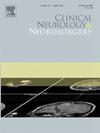急性缺血性脑卒中患者新发现心房颤动的脑损伤和超声心动图预测因素。
IF 1.8
4区 医学
Q3 CLINICAL NEUROLOGY
引用次数: 0
摘要
目的:心房颤动(AF)是急性缺血性脑卒中(AIS)臭名昭著的危险因素之一,使用抗凝剂已被证明可有效预防心房颤动患者的缺血性脑卒中。因此,在 AIS 患者中识别房颤变得越来越重要。然而,脑成像和心脏指数对卒中后新发房颤的影响仍不明确:方法:对 2013 年 1 月至 2019 年 12 月期间在蔚山大学医院住院的 AIS 患者进行连续系列研究。纳入核磁共振成像有相关脑缺血病变的患者,排除无超声心动图数据的患者。我们纳入了在住院前或住院期间患病或符合隐源性卒中(CS)标准的房颤患者,并对其进行了分类。我们调查了每组患者在基线特征、卒中危险因素、卒中严重程度、岛叶病损和超声心动图数据方面的差异:研究共招募了 850 名患者,包括 231 名卒中后检测到房颤的患者(AFDAS)、287 名已知房颤的患者(KAF)和 350 名 CS 患者。与已知房颤患者相比,AFDAS 患者潜在冠心病和中风病史的发生率较低。在未经调整的分析中,他们的右侧岛叶皮质病变较多,左心房增大较少。调整分析后发现,右侧岛叶皮质受累与 AFDAS 患者组有关(几率比 1.57)。与 CS 组相比,AFDAS 患者年龄更大,初次中风更严重,中风前抗凝处方的比例相似。此外,AFDAS 患者的岛叶病变发生率更高,左心房容积指数增加,射血分数降低,e/e'比值升高。经调整后发现,年龄、初始中风严重程度、岛叶受累、左心房容积指数、射血分数和e/e'比值均有显著性差异:这些结果表明,急性卒中右侧岛叶皮质病变可能是 AFDAS 的病因之一。本文章由计算机程序翻译,如有差异,请以英文原文为准。
Brain lesion and echocardiogenic predictors of newly detected atrial fibrillation in acute ischemic stroke
Objectives
Atrial fibrillation (AF) is one of the notorious risk factors in acute ischemic stroke (AIS), and the use of anticoagulants has been shown to be effective in preventing ischemic stroke in AF patients. Therefore, identifying AF in AIS patients has become increasingly important. However, the impact of brain imaging and cardiac indices on the development of new AF after stroke remains unclear.
Methods
A consecutive series of AIS patients who were admitted to the Ulsan University Hospital between January 2013 and December 2019 were identified. Patients with relevant ischemic brain lesions on MRI were included, and those without echocardiography data were excluded. We included and classified the AF patients who had the disease prior to or during hospitalization or met the criteria for cryptogenic stroke (CS). Differences in baseline characteristics, stroke risk factors, stroke severity, insular lesion, and echocardiographic data were investigated among each group.
Results
A total of 850 patients were enrolled in the study, comprising 231 patients with AF detected after stroke (AFDAS), 287 patients with known AF (KAF), and 350 patients with CS. Compared with KAF, patients with AFDAS had a lower prevalence of underlying coronary heart disease and stroke history. They had greater right insular cortex lesions and lesser left atrial enlargement in unadjusted analysis. Following adjusted analysis, the involvement of the right insular cortex was found to be associated with the AFDAS patient group (odds ratio, 1.57). When compared to the CS group, AFDAS patients were older, experienced more severe initial strokes, and had similar rates of pre-stroke anticoagulation prescription. Additionally, they demonstrated a higher prevalence of both insular lesions, increased left atrium volume index, reduced ejection fraction, and elevated e/e′ ratio. After adjustment, age, initial stroke severity, insular involvement, left atrium volume index, ejection fraction, and e/e′ ratio were found to be significant.
Conclusions
These results suggest that the right insular cortex lesion on acute stroke may be a cause of AFDAS.
求助全文
通过发布文献求助,成功后即可免费获取论文全文。
去求助
来源期刊

Clinical Neurology and Neurosurgery
医学-临床神经学
CiteScore
3.70
自引率
5.30%
发文量
358
审稿时长
46 days
期刊介绍:
Clinical Neurology and Neurosurgery is devoted to publishing papers and reports on the clinical aspects of neurology and neurosurgery. It is an international forum for papers of high scientific standard that are of interest to Neurologists and Neurosurgeons world-wide.
 求助内容:
求助内容: 应助结果提醒方式:
应助结果提醒方式:


